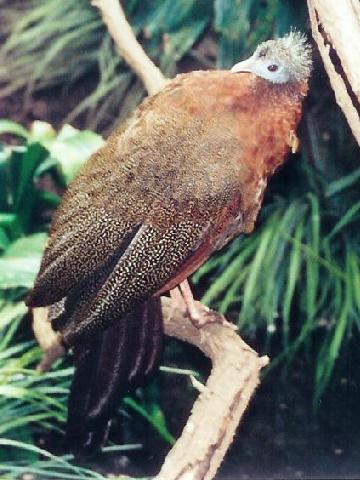|
| Query: argusianus | Result: 2nd of 53 | |
Great Argus (Argusianus argus) - Wiki
| Subject: | Great Argus (Argusianus argus) - Wiki
| |

| Resolution: 360x480
File Size: 38063 Bytes
Upload Date: 2007:09:24 08:07:35
|
Great Argus
From Wikipedia, the free encyclopedia
[Photo] Description: Great Argus - Source: own work - Location: Bronx Zoo, New York - Author: http://commons.wikimedia.org/wiki/User:Stavenn | Permission is granted to copy, distribute and/or modify this document under the terms of the GNU Free Documentation License, Version 1.2 or any later version published by the Free Software Foundation; with no Invariant Sections, no Front-Cover Texts, and no Back-Cover Texts. A copy of the license is included in the section entitled "GNU Free Documentation License". |
The Great Argus, Argusianus argus is a brown-plumaged pheasant with a small blue head and neck, rufous red upper breast, a black hair-like feathers on crown and nape, and red legs. The male is among the largest of all pheasants, with up to 200cm in length. It has a very long tail feathers. The male's most spectacular features are its huge, broad and greatly elongated secondary wing feathers decorated with large ocelli. The female is smaller and duller than male, with shorter tail and less ocelli. Young males attain adult plumage in their third years.
The Great Argus is distributed in the jungles of Borneo, Sumatra and Malay Peninsula in southeast Asia. It feeds on forest floor in early morning and evening. Unusual among Galliformes, the Great Argus has no oil gland and the hen lays only two eggs.
Though the Great Argus is not as colorful as other pheasants, its display surely ranks among the most remarkable. The male clears an open spot in the forest and prepares a dancing ground. He announces himself with loud calls to attract females, then he dances before her with his wings spread into two enormous fans, revealing hundred of "eyes" while his real eyes are hidden behind it, staring at her.
Despite displays similar to polygamous birds and though the Great Argus is thought to be polygamous in the wild, it is actually monogamous.
The scientific name of the Great Argus was given by Carolus Linnaeus in reference to the many eyes-like pattern on its wings. Argus is a hundred eyes giant in Greek mythology.
Due to ongoing habitat loss and hunted in some areas, the Great Argus is evaluated as Near Threatened on the IUCN Red List. It is listed on Appendix II of CITES.
http://en.wikipedia.org/wiki/Great_Argus
| The text in this page is based on the copyrighted Wikipedia article shown in above URL. It is used under the GNU Free Documentation License. You may redistribute it, verbatim or modified, providing that you comply with the terms of the GFDL. |
|
Comments |
|---|
| | Guest |
|
Scientific Name: Argusianus argus (Linnaeus, 1766)
Common Names: Great Argus, Great Argus-pheasant
French: Argus géant; German: Argusfasan; Spanish: Argos real
Taxonomy: Phasianus Argus Linnaeus, 1766, "Tartaria Chinensi"; error = Sumatra. |
^o^
Animal Pictures Archive for smart phones
^o^
|
|
|